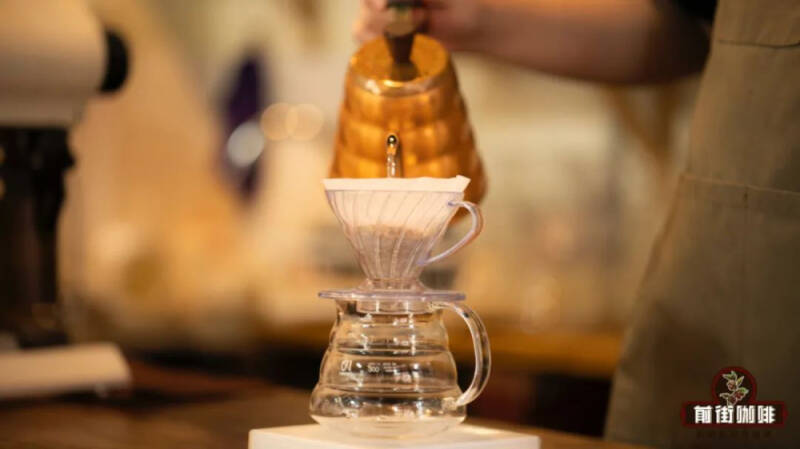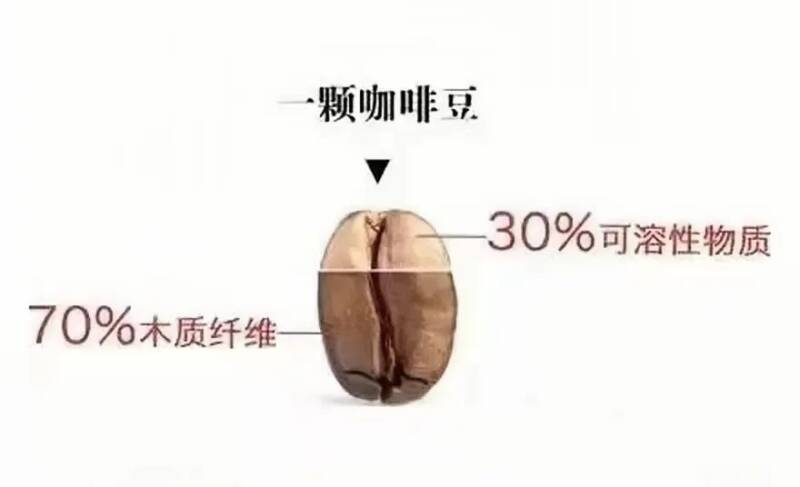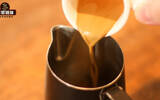What is the underlying logic of making coffee by hand? How to set grinding and water temperature? What impact does water quality have on coffee extraction?
Today, making coffee by hand is still a good thing for people. Because its brewing method is simple and convenient, it can also highlight the taste of the coffee itself! Not only that, the production process is also very healing, can make people feel physically and mentally comfortable. Therefore, many people have successively become "captives" of hand-made coffee.

As Qianjie said, it is more important to understand the underlying logic of brewing coffee than the way it is made. All cooking methods revolve around the formula derived from the extraction logic. Therefore, as long as you master the theory of extraction, then even if you are a beginner, you can get started and make a cup of coffee in the fastest time! At the same time, it can also analyze the operation principle of different cooking methods. So next we need to know, hand-brewed coffee, what is it?
What is the coffee brewed by hand? In fact, it's not just hand brewing, all coffee extracts are the same. We know that there are 30% soluble matter and 70% insoluble matter in a coffee bean. Insoluble substances mainly refer to the woody fibers of coffee, while soluble substances contain caffeine, proteins, sugars, carbohydrates, various acids, fats and other substances. The three major flavors of sour, sweet and bitter coffee are all included in it. What we need to do to extract coffee is to bring these flavors out.

The proportion of sour, sweet and bitter in coffee beans is mainly affected by the degree of roasting. The shallower the roasting, the higher the sour content of the coffee, and the deeper the roasting, the higher the bitter content. As the flavors will contain each other and blend with each other, different amounts of different flavors will lead to different performances of the final coffee. Therefore, in order to get a good cup of ideal coffee, what we need to do when extracting coffee is to extract these three flavors from coffee beans in a reasonable and appropriate amount. The dissolution rate of sour, sweet and bitter is different, the dissolution rate of sour substance is the fastest, and it will be brought out quickly under the washing of hot water, while the dissolution rate of bitter substance is the slowest, when the sour and sweet substance is extracted, only the bitter taste is still released because the dissolution rate is too slow. You know, bitterness is the most easily perceived taste in human taste buds, and when a small amount of it is present in coffee, it increases the overall mellow thickness, but when the proportion of bitterness in coffee is too high, it obscures other flavors. Therefore, we need to control the dissolution rate so that a small amount of bitterness is released without masking other flavors (yes, but not much).
But because we can't detect the amount of substance released, we can't know which stage is the peak of bitterness release. So at a time like this, we can understand the concept of Golden Cup! According to the Golden Cup survey, coffee with an extraction rate of 18% to 22% is the most popular. Because bitterness is an unpleasant existence for everyone, and it is more than released in the latter part. In other words, coffee with an extraction rate of more than 22% is unpleasant because it releases too much bitterness. So as long as we try to control the extraction rate within this range, we can avoid the release of a lot of bitterness and get a good cup of coffee! (but gold cup extraction is not absolute, do not apply it to all coffee, mainly by the taste of the drink to judge.) but if you want to extract these substances, you must need an extraction medium, so "water" played this role. It will help us dissolve the soluble matter in the coffee! In our daily life, seemingly colorless and tasteless water actually contains minerals (most). The amount of these substances determines the softness and hardness of the water, and at the same time, it can also affect the taste of coffee. But this is not very important compared to other factors, so we can just skip it, and friends who want to know more about it can move on to this article, "what water makes coffee better?" ". What we need to know more is how to use water to extract the substances from the coffee reasonably!
It is not difficult to extract the substances from the coffee, but the difficulty lies in how to extract the right amount. Therefore, we need to make a brewing plan to control the solubility of coffee substances! In the cooking scheme, there are four main factors that can be visualized: the ratio of powder to water, grinding, water temperature and cooking time. Although each factor exists independently, if you want to extract a reasonable amount of a cup of coffee, then these four factors must check each other and find a reasonable balance according to the efficiency of other factors. and this is what we call: controlling dissolution efficiency. So let's take a look at how these factors control the dissolution efficiency.
Warm water as a solvent in the extraction process, its temperature determines the degree of molecular movement! The higher the temperature, the more intense the molecular motion, in other words, the stronger the extraction efficiency.
The extraction efficiency determines the extraction speed of coffee. When other parameters are the same, the higher the water temperature is, the faster the substance will be extracted. Generally speaking, we need to determine the water temperature according to the roasting degree of coffee beans! Lightly roasted beans need higher water temperature to extract, because the baking time is short and their density is high, so hot water needs higher temperature to dissolve the substances in coffee; while deep-baked beans have low density, too high water temperature can easily lead to extraction of substances that should not be dissolved, so we need to lower the temperature to reduce the release rate of negative substances. (the water temperatures used in the front street are: light baking 91 °C ~ 93 °C; deep baking 87 °C ~ 89 °C)
Degree of grinding of coffee powder the degree of grinding of coffee powder determines the area that the flow of water can touch. The finer the grinding, the larger the surface area accessible to the water! At the same time, the shorter the distance from the outside to the center of the powder, the shorter the water can come into contact with the inside of the coffee powder, resulting in faster extraction.
Of course, grinding is not as fine as possible! Just like the water temperature, different bakes have different sizes. In addition, coffee powder will produce very fine particles (fine powder) when it is ground. The finer the grinding, the more very fine particles. Because its extraction efficiency is different from other large particles, so the right amount of fine powder can add a certain sense of layering to the coffee. But! If the amount of fine powder is too large, not only can not bring positive blessing to coffee, but also when brewing, these fine powders will easily plug the filter paper, prolong the extraction time of coffee, resulting in excessive extraction. (the grinders used in the front street are 80% of the over-screening rate of shallow drying of No. 20 screen and 75% of the over-screening rate of deep drying of No. 20 screen)
The ratio of powder to water refers to the ratio of the amount of coffee powder to the amount of water injected when making coffee. It mainly controls the concentration of a cup of coffee, when the extraction rate is the same, the higher the proportion of coffee concentration, and vice versa.
Similarly, the ratio of powder to water will be affected by other parameters and production methods! We need to adjust the proportion according to our taste preferences or the way we make it. (the proportion of powdered water used in front street is 1:15)
Brewing time the process of brewing coffee takes time, from the hot water to the coffee powder to the last drop of coffee liquid leaving the filter cup is our brewing time!
The longer the brewing time, the longer the contact time between hot water and coffee powder, so the higher the extraction efficiency; the shorter the cooking time, the lower the extraction efficiency under the same parameters. The time of brewing coffee is mainly affected by the speed of water infiltration, and there are many factors that can affect this aspect. For example, grinding! The finer the grinding, the smaller the gap between the powder and the powder, and the slower the water can penetrate, so the time is lengthened; or the ratio of powder to water! The smaller the proportion, the more hot water will be injected, and the time will also increase with the increase of the amount of water; and there is the filter paper filter cup! The thickness and material of the filter paper, as well as the diversion design of the filter cup will affect the water infiltration speed. (based on the above parameters, Qianjie will control the brewing time at 2 minutes ±5 seconds.) then, in addition to the above parameters that can be set, there is another factor that will affect the extraction efficiency of coffee, which is: water!
When we cook, we often use a circle to inject hot water. At the same time, the position of water injection will be constantly adjusted. The main purpose of these two operations is to drive the coffee powder to tumble (stir) through the impact of the water, so as to obtain higher extraction efficiency!
Qianjie still pulled out a used chestnut: Banlangen granules. We can compare it by making two cups of Radix Isatidis, the same hot water, the same dose, the difference is that one cup is stirred and the other is not stirred. Then we can find that the dissolution rate of the unstirred cup of Radix Isatidis must be slower than that of the strongly stirred cup. This is the kinetic energy brought by the impact of the current! The higher the impact of the injected water, the more violent the coffee powder will tumble and the faster the soluble matter will be dissolved. For more information, please follow this article → "the effect of Water flow on Coffee"
The above are several important factors that affect coffee extraction. They taste the same, they contain each other! When the extraction efficiency of one of the factors in an extraction formula is changed, if you want to extract the same delicious coffee, then the other factors have to be changed and the extraction efficiency will be modified! Most of the cooking methods we know are born by changing the extraction efficiency of a certain stage. Of course, there are many other factors that can affect cooking have not been mentioned, but Qianjie believes that for beginners, the above basic factors need to be familiar with and mastered before they can better absorb other knowledge. Then what we need to know is that it's important to visualize the data if you want to keep pouring out delicious coffee. Electronic scales for weighing, timers for timing, sieves for measuring and grinding, and thermometers for measuring water temperature are all objects that can visualize the data. When we are brewing, we only need to record the current brewing parameters, then we can freely correct or reappear in the brewed cup of coffee!
-END-
Important Notice :
前街咖啡 FrontStreet Coffee has moved to new addredd:
FrontStreet Coffee Address: 315,Donghua East Road,GuangZhou
Tel:020 38364473
- Prev

How to draw American coffee? What is the principle of latte flowers? How to steam espresso?
The birth of coffee pulling flowers has added great appeal to dairy espresso. Even people who have never been exposed to coffee will be attracted by the exquisite pulling flowers pattern and order a cup of "bitter" that they have never experienced in life. The act of pulling flowers is called "Latte Art", Latte Art. Care big
- Next

The satirical cup set is removed from the shelf! The fragrant traffic drops a little fast!
▲ Click to pay attention| Daily Boutique Coffee Culture Magazine Coffee Factory Recently, the well-known domestic milk tea brand Xiangpiao has become an active member on the hot search list. There has been a hot search associated with it for several days, becoming an eye-catching "light of domestic products." The reason why Fragrant Piao will become so popular in a short period of time is that we must go from one person to another.
Related
- What is the difference between a cake filter cup and a V60 conical filter cup? What are the advantages and disadvantages of the flat-bottomed filter cup brewing solution?
- What is the difference between fine coffee powder and medium coarse coffee powder? Do I need to sift out the fine coffee powder for making coffee by hand?
- Why does hot American coffee taste bitter? Difference in proportional concentration between hot American and ice American
- Is espresso stored overnight in the refrigerator harmful to your body? Is frozen coffee better than freshly ground coffee?
- What parameters and proportions of water temperature should be used to grind and brew fresh coffee beans? Why can't I drink freshly roasted coffee right away?
- Customers have "changed" Manner's new products! Shop assistant: Please don't mess around!
- Remove sockets in customer areas at Starbucks stores?! Netizen: I won't go if I really tear it down
- What is the difference between the taste steps of sun-dried coffee and washed coffee? Why is sun-cured coffee sweeter and washed coffee sour?
- The recipe for salty grapefruit dirty is revealed! Coffee Festival salty grapefruit dirty coffee making materials parameters ratio milk share!
- How about the flavor of Sunlight 74158 at Sidamo Banshaha Mathieu Processing Factory in Ethiopia? 74158 Share the proportion of coffee brewing parameters!

